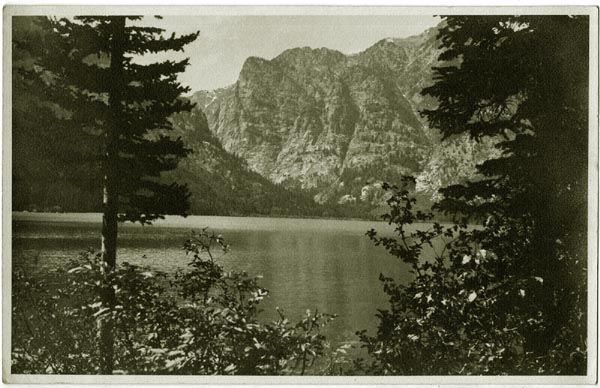
Death Canyon as viewed from across Phelps Lake, 1924, photo by J.E. Stimson.
By the end of 1899, many of the troops from the Spanish-American War who fought in Cuba or Puerto Rico had been
mustered out. And as it was at the end of the 2nd Seminole War, the Mexican War, and the Civil War,
veterans imbued with an American sense of self-sufficiency looked for land
which the government made available for settling and agriculture. Jackson's Hole, as it was then
known, became available for homesteading. In 1897, Thomas Bannon had surveyed parts of the northern
valley. Later Mount Bannon which looms in the distance beyond Death Canyon across from Phelps Lake was named for him.
The Lake was named by the Haydon party which came into the area in 1872 for a trapper, George Phelps, who trapped in the area and
served as a local guide for the Hayden expedition. Various hunters came into the area on short expeditions and then
wrote of their adventuresin various magazines, but generally the area was empty. No one really knows how Death Canyon
received its name. It has been speculated that it may have received its name as a result of
49'ers attemting to reach Idaho up the Canyon. Others contend that it received its name from
an Indian conflict, or as a result of a surveyor from the Bannon surveying party disappearing in its
environs.
Following the Civil War one veteran who wandered westward was David W. Spalding (1844-1924). At first he landed in
Dakota Territory where he proved up a homestead in Brule County in 1884. From there he moved westward and
by 1901 or 02 landed near Wilson in Jackson's Hole. There he began homesteading near Phelps Lake. About 1901-02. He sold his interest
to Louis H. Joy (1873-1939) who, with additional land, established in 1908 in conjunction with
Philadelphia writer Maxwell Struthers Burt (1882-1954), the J Y Ranch at the head of Phelps Lake.
Spalding was interred on the
J Y Ranch.
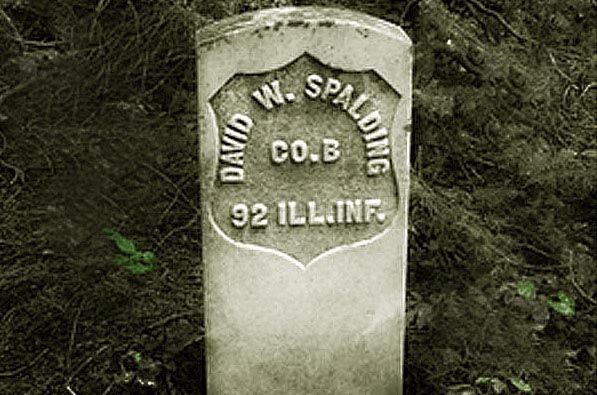
David W. Spalding grave marker on the former J Y Ranch.
The name of the ranch was taken by abreviating
Joy's last name.
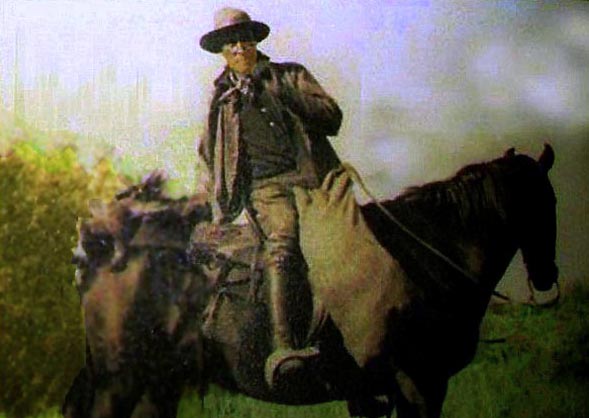
Louis H. Joy, approx. 1906.
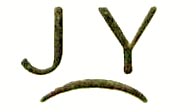 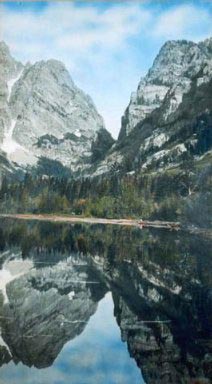
Left, JY Ranch Brand;
Right, Death Canyon, 1899, by J.E. Stimson.
The ranch is generally regarded as the first dude ranch in
Jackson Hole. The Brand for the ranch was, however, the J Y Quarter Circle depicted to the left. There was apparently an understanding
that Joy would sell a fifty per cent interest in the ranch to Burt. Joy was the actual owner of the lands which the ranch
occupied. By 1912 differences had arisen between Burt and Joy. Burt began to realize that the sale of the fifty per cent was not going to happen.
Burt sold his interest in
the J Y and With
Dr. Horace Camcross established the Bar B C in Spring Gulch near Moose. Burt's new ranch
bore the initials of Burt and Camcross.In 1916 Joy leased the J Y to
Henry S. A. Stewart, Jr. (1890-1955) of Pittsburgh, Pennslvania. Stewart's father,
was a very wealthy businessman with interests in steel ( Crucible Steel Co.) and banking.
Various writers such as Idaho Falls physician B. F. Jones, and Owen Wister brought
Death Canyon to the fore. Dr. Jonesin his 1897 article in Recreation Magazine "Hunting in Jackson's Hole"
wrote of being guided into the Canyon by Stephen Leek.
It took three days to go from Rexburg, Idaho, to Leek's ranch. After several days at the ranch
in peparation and a day to go the 15 1/2 miles to the entrance of the Canyon:
The morning sun rose clear and bright, and by 10 o'clock we were mounted and on our way to the big Teton, with our camp outfit on an extra horse. On our way we saw several bands of antelope travelling along their well beaten trails, and hundreds of sage grouse, to which we paid no attention. We crossed the broad, shallow Snake river and ascended the foot of Death Canyon in which lies Jennie's lake. We halted here a few moments and viewed the beautiful scenery. The lake, as compared to the huge mountains, seemed like a handful and when informed, by Steve, that it was 3 miles long by 2 in width I could scarcely believe it. Clouds began to roll along the range, from which snow fell, while with us it rained and before our tent was pitched we were quite wet. Horses were picketed, fuel gathered, a big fire built and we were soon comfortable.
Next morning we made our way up into the depths of the great canyon. Huge clouds began to roll from the South along the range, obscuring entirely our view of the higher points. Selecting a favorable moment several exposures were made. After ascending to a considerable height a perfect view of the lake below presented itself. Many swans were leisurely swimming around in the water.
All day was spent exploring this great canyon yet we did not succeed in reaching half way into its great depths. Retracing our steps over the rocky pathway we arrived at camp tired and ravenously hungry. As usual we had a roaring fire, made of dry spruce trees, felled for the purpose, with a goodly quantity of pitch pine stumps.
Next morning we awoke to find the weather dark and threatening and the ground covered with snow: so, on account of the unfavorable outlook, we decided to break camp. While passing around the lake 8 deer jumped up ahead of us and disappeared in the thick undergrowth.
We made a forced march homeward, flashing hundreds of sage grouse and ducks to which no attention was paid until in sight of the ranch, when I bagged a pair of mallards.
Next morning Steve and I went South 3 miles to Wilson's gulch, securing some views and 3 fine specimens for mounting. On our way home we noticed some moving objects, high up on the mountain side, a long distance, which proved to be about 50 antelope on their way South. No effort was made to kill any of them, but we watched them out of sight.
Wister, who had visited Jackson Hole in the 1880's and 1890's, in his 1902 "The Virginian," described a little known canyon southward from the Conant Trail:
We gained the rim of the basin. It lay below us, a great cup of country,órocks, woods, opens, and streams. The tall peaks rose like spires around it, magnificent
and bare in the last of the sun; and we surveyed this upper world,
letting our animals get breath. Our bleak, crumbled rim ran like a
rampart between the towering tops, a half circle of five miles or six,
very wide in some parts, and in some shrinking to a scanty foothold,
as here. Here our trail crossed over it between two eroded and
fantastic shapes of stone, like mushrooms, or misshapen heads on
pikes. Banks of snow spread up here against the black rocks, but half
an hour would see us descended to the green and the woods. I looked
down, both of us looked down, but our forerunners were not there.
In 1911, Wister again returned staying at the J Y. He later constructed a private retreat in the valley.
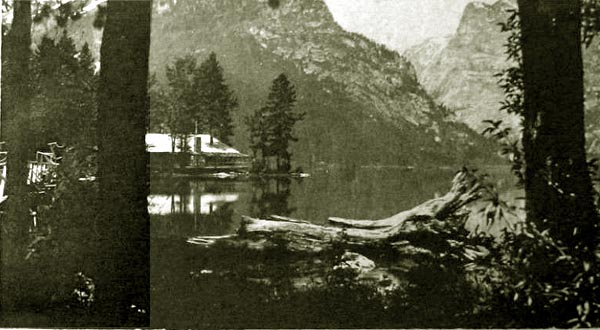
View of J Y boathouse and entrance to
Death Canyon across Phelps Lake, approx. 1924, Photo by J. E. Stimson.
Further publicity came in the form of reviews of Wister's "The Virginian" and other articles.
In February 1916, the "Cornell Women's Review" published an account of
a group of co-eds who, inspired by Wister, made the journey up up Death Canyon.
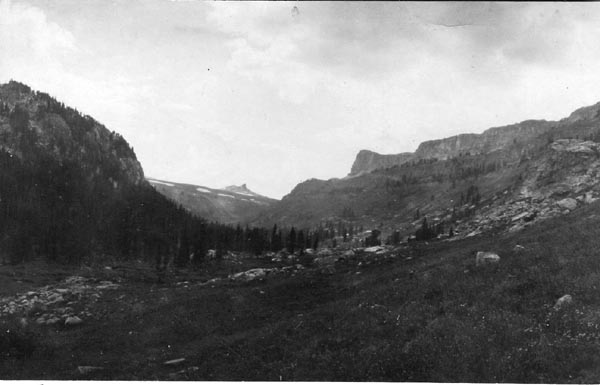
Upper reaches of Death Canyon, undated.
In 1920, Henry S. A. Stewart, Jr. (Henry Stanley Armstrong Stewart, Jr.) purchased The J Y. Apparently he had ambitious plans for the property. The October 16 issue of
Hotel World, p. 16, noted that plans had been made for the construction of a large hotel and some 100 summer houses for
the property at Phelps Lake. A major feature of the development was to be Death Canyon. The hotel and the summer house were not,
however, constructed. In the operation of the ranch
Stewart was high, wide and handsome. The ranch was expanded. It was allegedly the only ranch in the valley that served
beef rather than elk. It served fresh vegetables rather than the normal tinned vegetables. Guests had available a motor coach in which they were taken on
trips to the sights of Yellowstone. It was a first class operation.
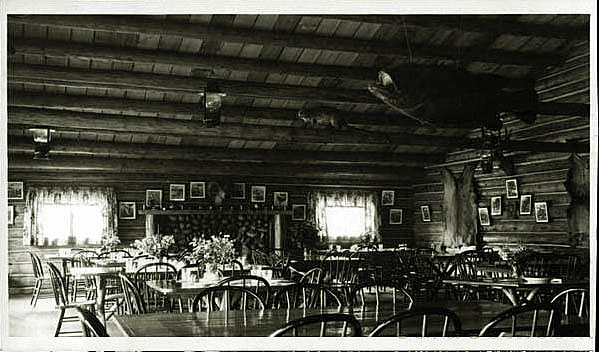
J Y Ranch Dining Room, Photo by Harrison "Hank" Crandall, approx. 1925.
John D. Rockefeller, Jr. was interested in preserving the valley and perhaps establishing a personal preserve. Rockefeller's
proposals were not well received in the valley. One of the first to cave and sell was Stewart, Jr. The J Y appeared to be successful, unlike other
ranches in the valley hurt by the Depression. It improved its services and unlike other dude ranches in the area actually
increased its rates. With all of his father's fortune there was no need to sell. The elder
Stewart had died in 1921. Probably not widely known in the valley was that
the elder Stewart probably knew his son all too well. The younger Stewart was not a businessman. Instead he was a wastrel.
The elder Stewart shortly before his death in an attempt to
protect his son from his prolifigate ways
created two "spendthift trusts" which limited
his son's access to the family fortune.
As discussed by the Pennsylvania Supreme Court in Stewart's Estate,5 A.2d 910, 334 Pa. 356 (1939), the younger
Stewart had been married four times and had agreed to pay large sums in Alimony. In the third marriage,
the Florida Courts refused to award him a divorce, but nevertheless awarded the wife permanent alimony as well as her counsel fees paid monthly. Not withstanding the lack of a divorce
from wife number three, Stewart married a fourth time in Yucatan, Mexico. Regardless of court orders requiring alimony to be paid from receipts from
the trusts, the court orders were ignored and various other unsuccessful actions were brought attempting to levy on Stewart's assets, but no other
assets could be found except funds received from the spendthrift trusts. Stweart in 1932 had sold the J Y to Rockefeller and the proceeds apparently had been dissipated.
Indeed, Stewart even coveyed a major portion of the anticipated future income from the trusts to relatives of the putative fourth wife.
The Pennsylvania Court reached back
he Fraudulent Conveyances Act of 1571 (13 Eliz 1, c 5) to hold the conveyance to
relatives of wife no. 4 fraudulent. At the time in Pennyslvania and not withstanding the American Revolution, the Act was still in full force and effect. Indeed, in parts ofthe Commonwealth it is
still in effect. The affect of the ruling was that more than half of Stewart's estimated $38,000 annual income
income from the trusts went to his wives and wife no. 4. Additionally he had his own unpaid lawyers suing and nipping at his heels. I.R.S also got into the act,
and held that moneys paid to the ex-wives were constructively his and he had to pay income taxes on
them.
The younger Stewart with wife no. five, moved to France, only have to flee in advance of
the German invasion. The two then moved to Cuba but then ultimately moved back to the United States several years before the
fall of the Batista regime. Henry S. A. Stewart, Jr. died in Deleware in 1955 survived by wives no. 2 and 5 who prompltly sued each
other as to who inherited the principal of Stewart Sr's fortune. Wife No. 5, Elizabeth Gilpin Wales Stewart, won. See
Pittsburgh Post Gazette, April 14, 1956, p. 3.
There once was an old man of Lyme
Who married three wives at a time,
When asked, "Why a third?"
He replied, "One's absurd!
And bigamy, sir, is a crime.
John D. Rockefeller, Jr. conveyed much of his holdings in Jackson Hole to
the National Park Service. They formed the basic beginnings of the Teton National Park. He held on, however,
to the J Y Ranch which he left to Laurence Rockefeller. Over the years the
J. Y. Quarter Circle brand stood proudly over the gate to the ranch. The Rockefellers used the
maintained the ranch as a family retreat away from the pressures and formality of the East. For most of the post-war years a cowboy,
"Red" Mathews, who grew up in Wheatland was the caretaker for the
J. Y. Quarter Circle. He was, of course, more than a caretaker for the ranch and indeed was a part of the extended Rockefeller
family when they were visiting the ranch in the summers. In May 2001 Laurence honoring his father's wish, announced that the
J. Y. was to be conveyed to the National Park Service after first removing the buildings and letting the
ranch was to return to nature. The main lodge, tack shed and barn were moved to the Granite Ranch. Other building were placed
elsewhere on National Park properties.
Red ultimatelly retired first to south of Cheyenne and later to Cottonwood, Arizona, where he died in 2006. In 2011, John D. Rockefeller's grand daughter, Laura Rockefeller Chasin (1936-2015), wrote of Red in
a privately published and distributed book of remembrances of Red and the J Y. The book is not for sale.
An inscribed copy sits on a shelf behind my desk, not on the overstuffed shelves upstairs. I am grateful.
GBD
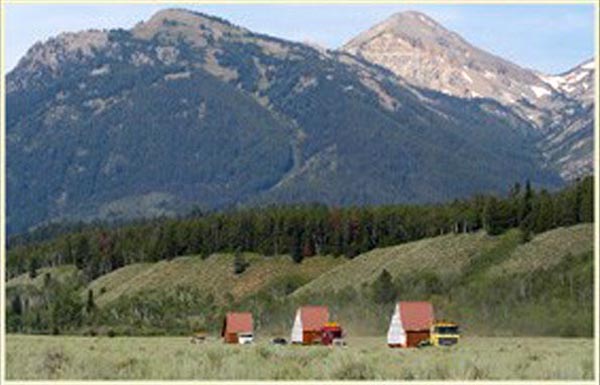
Distant view of Moving buildings off the J Y, 2004.
For discussion of the origin of dude ranching in
the West, see Eaton Brothers.
Music this page: "It Makes no Difference Now"
As performed by Montana Slim.
Next page: The Bar B C.
|